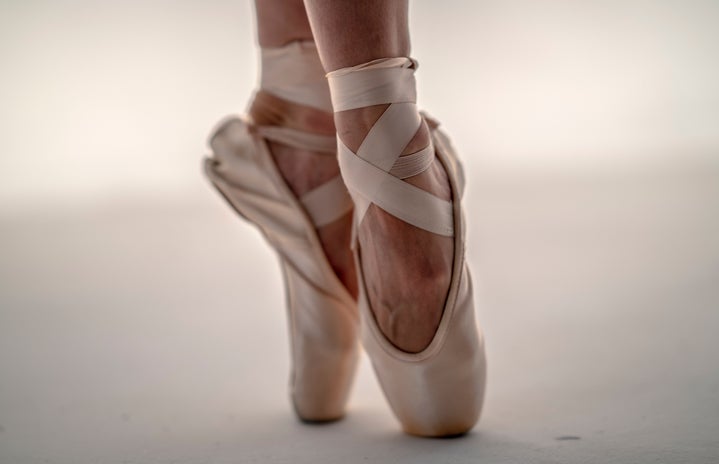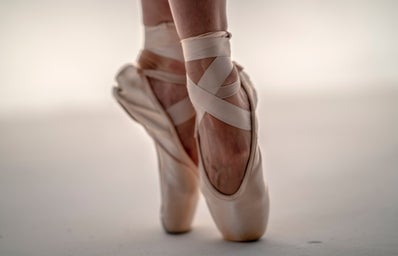I am 12 years old, in a room that would be peculiar to anyone not familiar. One wall is lined entirely with mirrors and horizontal wooden polls are drilled into the walls. There are 13 girls, including myself, all in identical uniforms of the same black Capezio leotard. Our hair is pulled back into tight buns complete with dozens of bobby pins that poke our scalps in the most painful places.
We spend the next two hours volunteering our bodies to excruciating pain. Our legs quiver as we hold degagés. We grit our teeth as our teacher presses her foot down onto our backs to ensure that our hips are fully on the ground as we hold middle splits against the wall. Our toes bleed within 10 minutes of dancing en pointe and it’s not uncommon for someone to twist their ankle and then get right back up, ignoring the pain. We dance through broken toes, shin splints, torn achilles tendons, and we are trained to make it look easy.
A dancer’s relationship to the sport is the same as a toxic romance. I hated how much I loved it. I hated how I loved the pain it caused me, because it was a rite of passage. My middle school years were spent leaving school early to make it to ballet on time. I spent every day from 3:00 to 9:00 at the studio, trying to finish up essays for school in our ten minute breaks. My weekends were spent off at dance competitions with cringe worthy names like “Star Power” and “NRG” or at long auditions for ballet summer programs.
Ballet is a structured art. Every single movement must be perfect. If your leg is even one degree above where George Balanchine declared it should be in his choreography, you’re wrong. But still, the studio was my safe space. The intense structure was a welcoming distraction to a world that felt so out of control. There, in the world of precise movements and instruction, I could let go.
Many small children are enrolled in ballet class but as I got older, the numbers dwindled. My close friends at school who had been in beginner ballet with me didn’t care about dance by the time we were 8. They didn’t understand why I couldn’t hang out after school or on the weekends. They didn’t get why I couldn’t skip dance, just this once.
The age of 11 is a critical moment for a ballerina. For many, it is when they are allowed to go on pointe for the first time. It is what so many of us dreamed about for years, as we watched the older girls at the studio perform variations from Coppélia and Swan Lake. It is when we all must decide which path to take: Is this a hobby or is this a career?
I never doubted that ballet would be my career. In my fifth grade yearbook, I am quoted as saying that “In 20 years, I will be dancing with the Royal Ballet in London.”
I wonder what younger me would say if I told her that I barely dance anymore. I recently took my first contemporary class in months and it’s been years since I’ve succumbed my feet to the excruciating pain of pointe work, though a brand new pair of shoes sits in my closet, “just in case.” I never imagined that I would become one of the many ballerinas that give up on the dream. But I did.
I stopped dancing when I was 15. That year, I had worked my way into my studio’s Junior Company, the elite competition team for my age group. When I arrived for my first day at our summer bootcamp, something felt off. My body no longer looked like the other girls in the room and I couldn’t stand it. I wanted to crawl out of my own skin, shedding the person I was so that I could be like them.
It took me a long time to admit to myself that body dysmorphia was a big reason that I stopped dancing. It felt superficial that I gave up on my life-long passion because of the way I looked. But it’s impossible not to compare yourself when you spend hours upon hours staring in the mirror in a skin tight leotard, being told to suck in your stomach by teachers, and encouraged to diet at 10 years old. Talk to any dancer and they’ll most likely tell you that they’ve experienced the same things. It didn’t matter how many times I was praised for having “ideal dancer’s feet” or how many levels beyond my age group I was given permission to dance with. I would never have the right body.
Growing up dedicating your entire life to something and then stopping is an incredibly isolating feeling. Ballet was my entire world. Every waking minute was spent in the studio. My favorite movie was Center Stage, my favorite show was Dance Academy, and my favorite book was A Very Young Dancer. I wore my hair in a bun to school to signal to my peers that ballet was who I was, not just something that I did.
I still have every pair of pointe shoes that I’ve worn. The Russian Pointes that I chose for my first pair. The Grishkos that I ended up despising and killing within two days of classes. Countless pairs of Bloch Sonatas, the shoe that became my go-to’s.
The shoes may have no physical use anymore, but they still mean more to me than most of the things that I own. I can’t picture a world where I don’t have those shoes in my possession, even if they’re collecting dust in a closet.
Leaving ballet is a unique experience that only other “retired” ballerinas can understand. I still find myself doing tendus while I brush my teeth or absentmindedly marking the variation that I performed years ago. There’s a slight sting when I see a ballet or walk by Lincoln Center now. Recently, Misty Copeland sat down next to me on the subway and my heart still fluttered with the same excitement it did when I watched her dance as a child.
I know that the dream that I put countless hours into will never come true. But ballet is ingrained in me like a childhood friend. It will always be a part of me. Even if I never dance again, I will forever be a ballerina.


